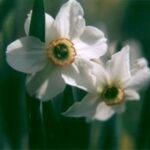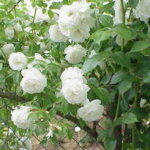The Royal Gold climber was planted seven years ago. It is a Dennison Morey origination that was introduced by Jackson and Perkins in 1987. It is a cross of climbing Goldilocks X Lydia. Goldilocks is a dainty, deep yellow floribunda that was introduced in 1945. One of the plants in the Jackson & Perkins, fields sported a climbing cane which was propagated and introduced as a climber in 1971. Lydia is a high centered, fragrant, intense saffron-yellow rose with a long pointed bud. Royal Gold inherited the best points of both its parents.
It has a most attractive ovid bud that opens, to a double bloom with 30 to 40 petals (petallage depends upon the weather) and a fruity fragrance. Blooms are borne both singly and in clusters. The foliage is quite glossy and remarkably resistant to disease and insect damage. I have grown this rose for several years and like Mrs. D’Arcy haven’t been bothered with either insect pests or disease on this particular plant. However, in both the D’Arcy garden and in my garden the plant is sprayed once a week when all the other roses are sprayed.
Mrs. D’Arcy is a member of the San Mateo County Rose Society and follows Rose Society principles in caring for her roses. This climber was set out bare root in a hole spaced 18 inches from the fence. She used the recommended soil mixture of excavated soil, humus material and alfalfa meal. The roots were arranged over a cone of prepared soil in the hole so that the base of the bud union was just above normal soil level. The hole was partially filled in, the soil firmed with the hands about the roots so no air pockets would be left and the area soaked. Extra soil was heaped over the bud union to encourage basal breaks from the bud union.
The fence was the support. Staples were driven into the fence at needed points and the canes were tied loosely to these staples. Mrs. D’Arcy does her own rose pruning and spraying. She keeps the canes from clambering over the fence by climbing on a ladder and cutting back any wayward canes. The result is a neat, very floriferous plant that provides a wall of bloom.
Climbers can be a joy or a headache, depending upon the gardener. The first year after a climbing rose is set out it is not supposed to bloom, it is too busy developing climbing wood. This new climbing wood should be held in an upright position until early the following spring when it will be mature enough to bend without breaking. Plan how you want the canes to go then gently bend them to fit your plan and hold them in this position by tying them to the support.
Be sure to plant them far enough away from a solid fence or wall so air may circulate behind the canes and so the spray nozzle can be used from behind to give complete coverage. The blooms are borne on laterals that come out at each leaf node along the climbing canes. More laterals will develop along a horizontal cane then along a perpendicular one.
Be sure to space the canes to allow these laterals to develop properly. When cutting blooms, both fresh and spent, be sure to leaves at least two sets of leaves on the lateral. New flowering stems will develop from the leaf nodes on these laterals and provide you with more blooms. Royal Gold is a good repeat bloom when the old blooms are removed promptly before they can start becoming seed.
Source:
Royal Gold Rose



